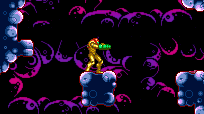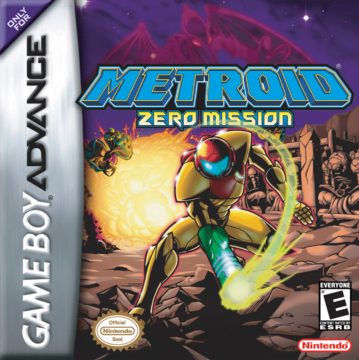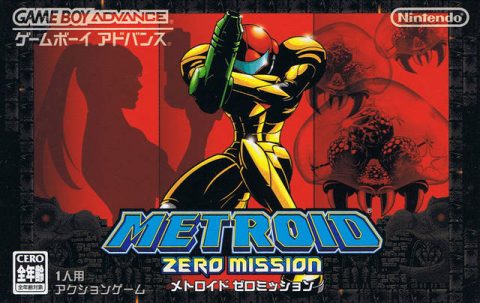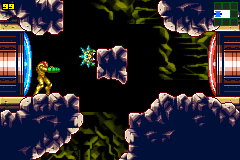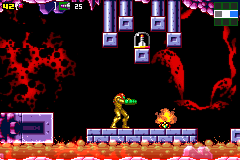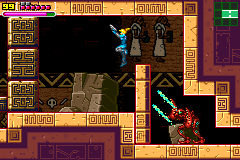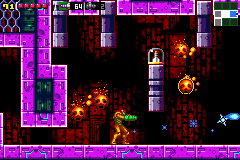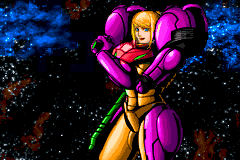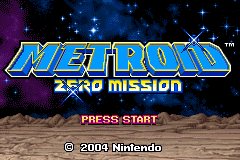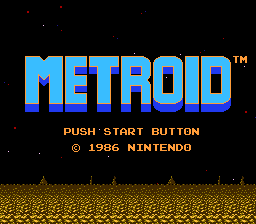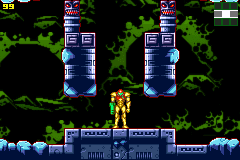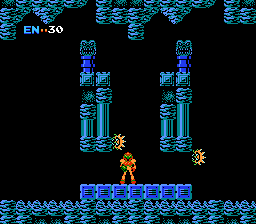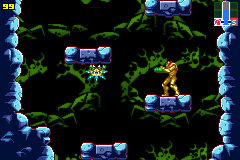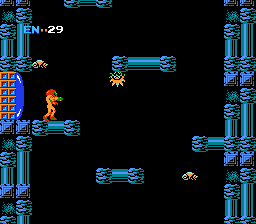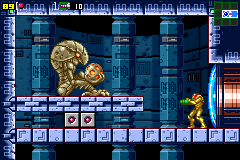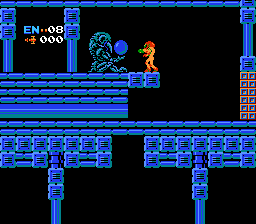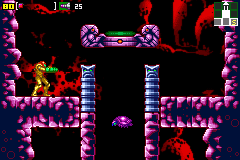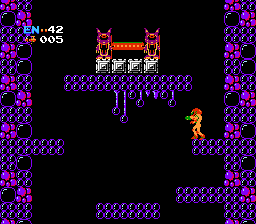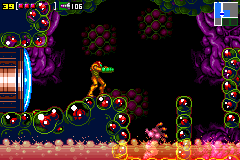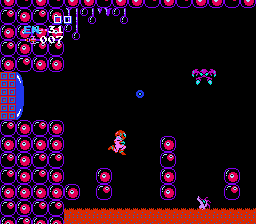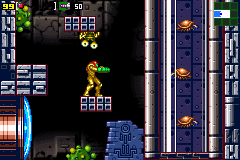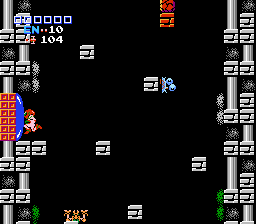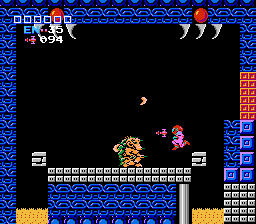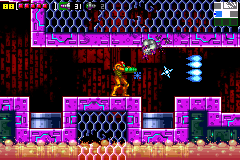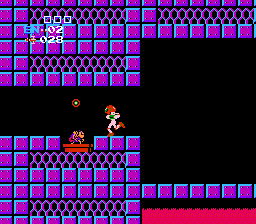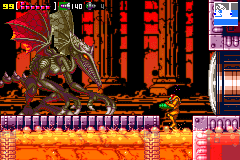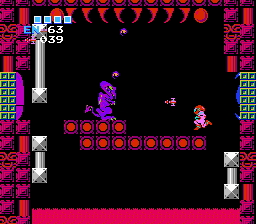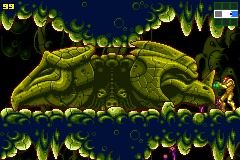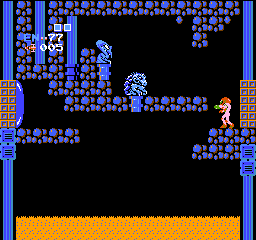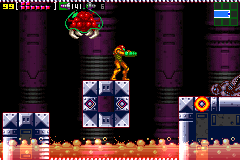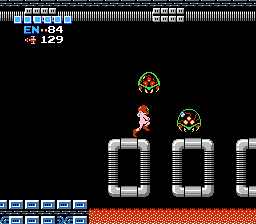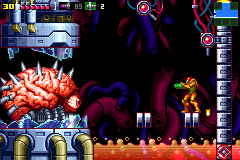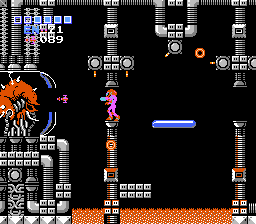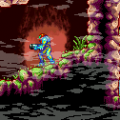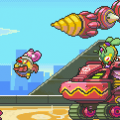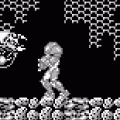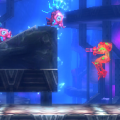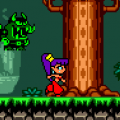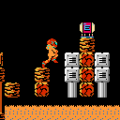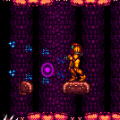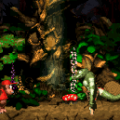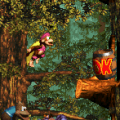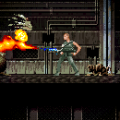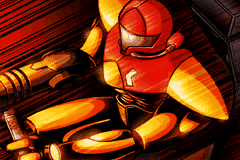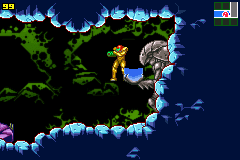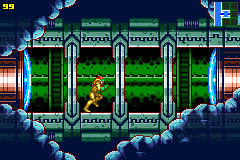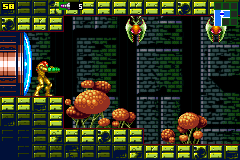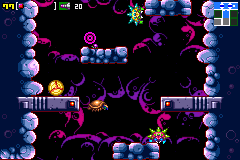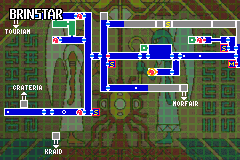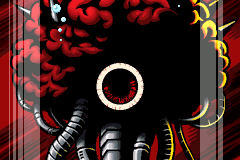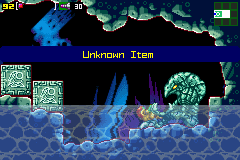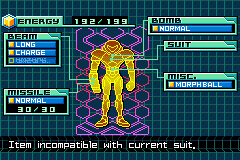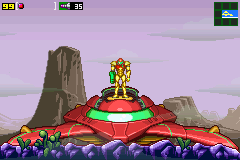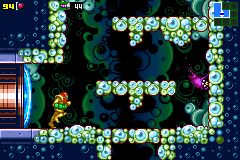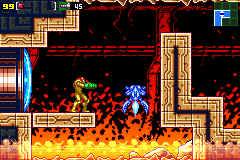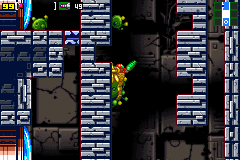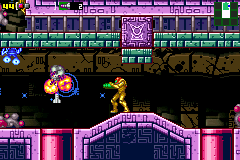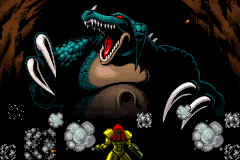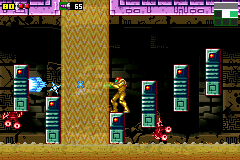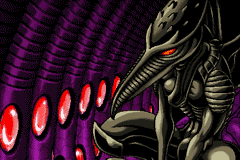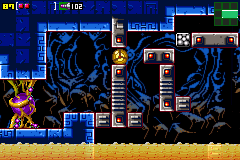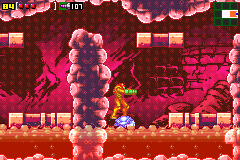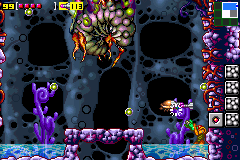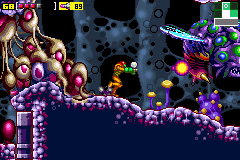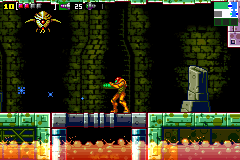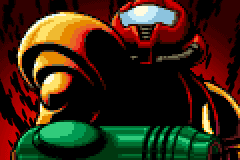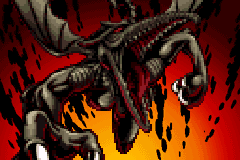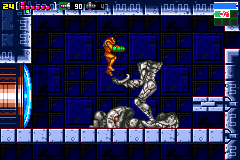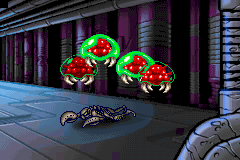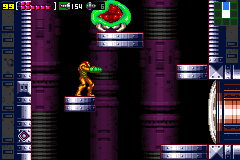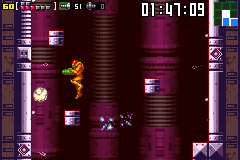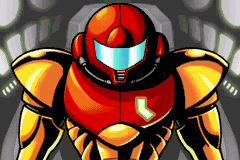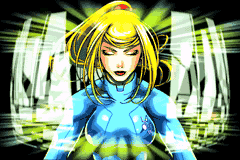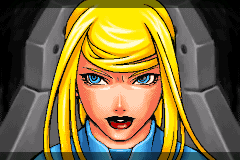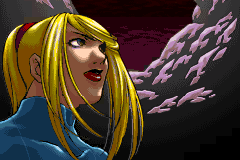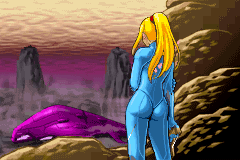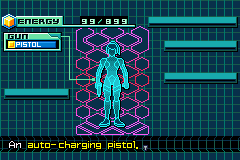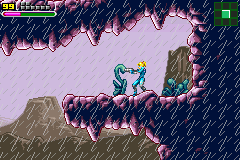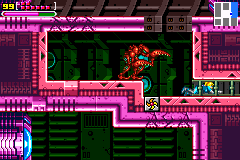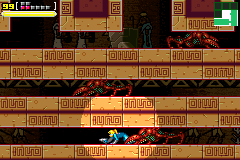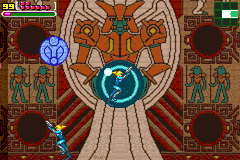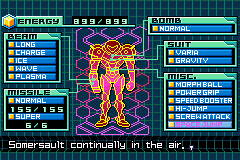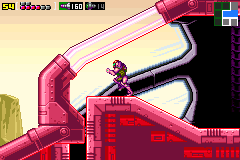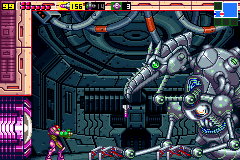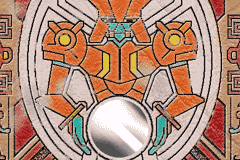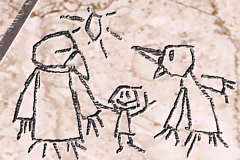The dual release of Metroid Prime and Metroid Fusion brought a new spotlight on the Metroid series, bringing in a number of new fans. But while Super Metroid was still perfectly playable for modern gamers, the first two games lacked many of the accommodating features that later games had implemented. And so, Nintendo developer Metroid: Zero Mission, a ground-up remake of the first game, in the style of Super Metroid (and using a few elements from Metroid Fusion as well).
The game thankfully eschews the wordiness of Fusion, as the introduction delivers a simple message: “Emergency Order: Exterminate all Metroid organisms on Planet Zebes and defeat the mechanical life-form, Mother Brain.” Samus’ ship rockets onto Zebes, lands, and then Samus makes her way down to Brinstar for the game to begin. There’s a brief monologue from Samus as well as a few comic book-style cutscenes during key moments (mostly as Samus rides elevators between zones), but until the last section of the game, there’s almost none of the pervasive story of Fusion, which is refreshing.
The controls feels a lot like Fusion, though Samus moves quicker here. The visual style, however, is unique among the series. Super Metroid’s dark visuals just weren’t going to work on the Game Boy Advance, particularly on the models that came before the backlights, so instead, it replicates the basic graphics of the first game and redraws them in a bright, comic book style. This also adds quite a bit of depth to the backgrounds, which were originally just stark black, while also adding some contrasting colors to certain areas. The music is similarly updated, with remixes that still manage to sound fantastic coming through the system’s low fidelity sound system.
The world map is patterned roughly after the original Metroid, but it’s still been heavily revised to feel more organic, cutting down on the the repetitive series of halls and corridors while adding some unique obstacles to the ones that remain. But it also adds a number of unique enemies, including some new mini-bosses, like a one-eyed worm that stalks you through the halls of Brinstar until you defeat it, and a slug (that later morphs into a winged insect) you face off against in Norfair and in Ridley’s Lair. (Remnants in the ROM indicate that you were meant to fight Crocomire from Super Metroid too.) A few new small areas have been added, including the surface (Crateria) as well as the Chozo Ruins.
Some of the items are placed in roughly the same area, but others have been placed in less hidden areas, like the Ice Beam. Most of the power-ups found in Super (the super dash, plasma beam and super bombs) have been added, as well as the Power Grip, which lets you grab onto ledges like in Fusion. There are also mystery upgrades that your suit can’t quite figure out (until it’s upgraded near the end of the game) but let you destroy certain types of blocks.
Certain Chozo statues will point you towards your next goal, but it works like it does in Metroid Prime, where it just points at a general location, which is often in unmapped territories. There are still map rooms that fill out most of the area, but there’s still plenty of explore in order to find them. In other words, it’s a good halfway point between the sometimes aimless wandering of the older games, and the super explicit guides from Fusion.
But with this, the game is also much more linear. Certain items that were optional in the original game are mandatory, like the Varia suit (needed to sustain the heat of Norfair) or the Screw Attack (needed to destroy certain blocks). You also used to be able to fight the mini-bosses in either order; now, it’s required to fight Kraid first. It’s also a substantially easier game. The venture through Tourian used to be harrowing, but now you’re so powerful, with weapons that aren’t just optional but stuff you need to find, that the Metroids are more like casual annoyances than something to be really feared.
Also, the game no longer ends once you destroy Mother Brain and escape. Instead, while Samus is flying away from Zebes, she’s shot down by the Space Pirate Mother Ship and forced back onto the planet’s surface. Seeing how the Power Suit was damaged during the attack, this is the first time you get to play as Samus in her Zero Suit outfit. In this form, she only has a stun gun, and most of her other powers (save for the Power Grip) are gone too. In this section of the game, you need to infiltrate the pirate ship, make your way to the Chozo Ruins and get a new Power Suit, before you can properly fight back and escape for real. Some elements of this area are stealth focused, as you try to hide from the eyes and spotlights of the pirates, but there are many spots where it’s impossible to avoid being sighted, so you just have to run and crawl until you get to a safer area. It seems to be an attempt to recall one of the times in Metroid Fusion where you need to escape from the SA-X, though on a much larger scale.
This part feels much different from other Metroid games, obviously, and while it goes on a little too long, it does make for a nice change of pace. Plus, it’s pretty gratifying to regain the Power Suit and be able to totally crush all of the enemies that previously hounded you. These additions also retroactively introduce some of the elements introduced later in the series, particularly the suit’s connection with the Chozo, as well as making Ridley out to be the true recurring antagonist of the series.
Although it’s not all that clear, you actually can re-enter the main hallways of Zebes in this final area, although only after a certain point. Though there’s nothing mandatory to do there, you can use it to pick up any items you may have missed. However, since the final encounter isn’t all that difficult, it’s not like you really need to go out of your way to do this unless you want a higher item completion percentage.
Still, even with all of the added stuff, Metroid: Zero Mission is a short game. The new areas in the main game are tiny, so it’s still just two main bosses, the Mother Brain fight in Tourian, and then the Zero Suit section. Even without speed running it, an average play time will probably take about three or four hours, primarily because Samus moves so quickly here, and because there’s very little room to actually get lost.
As with Fusion, there are plenty of arguments among Metroid fans if the feeling of being alone and lost within the labyrinth of the game world is one of the game’s essential features. While aspects like this are definitely missed, Zero Mission introduces other aspects to make up for it. A recurring theme is that Zebes is so hostile that the environment is hostile to everything in it, not just Samus. There are certain growths that are completely impervious to Samus’ fire; the only way to destroy them is to hunt down a colony of little flea-like creatures, which hound Samus’ suit but are otherwise mostly harmless. When you bring these things to the growth, the fleas will jump up and immediately destroy it for you. There are also vines which capture some enemies for you; during one of the mini-boss encounter, you actually find a larva entangled in one of these, and end up saving it in order to progress. However, once it hatches a few screens later, it’ll end up attacking you, clearly ungrateful that you just saved it moments before.
The concept is also, on some levels, a bit redundant. Super Metroid also had you exploring Zebes, with almost all of the same power-ups. So with Zero Mission, it’s basically just Super Metroid with a different graphical style and different music, using a map layout closer to the original game. That doesn’t mean that the game isn’t worth playing though, because the world design is still fantastic, and Metroid games are generally so brilliant that it’s hard to complain about more of them. Plus, it doesn’t entirely make the original NES game useless either. Those with less patience of the eccentricities of 80s action games can probably just play Zero Mission, but others can still experience the harsh difficulty of the older games, but then revisit them with remodeled graphics and extra elements in the remake.
Indeed, this seems to be the intent of Zero Mission. Once you beat the main game, you actually unlock the original NES game. It is a little unusual considering that this was also released as a standalone retail release for the GBA as part of the NES Classics series. The only distinction? In Japan, the equivalent Famicom Mini release used the FDS version; all versions of Zero Mission feature the NES ROM version instead (with a save feature to help alleviate the necessity of passwords, though that function is still there).
Screenshot Comparisons
